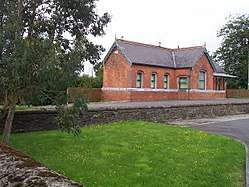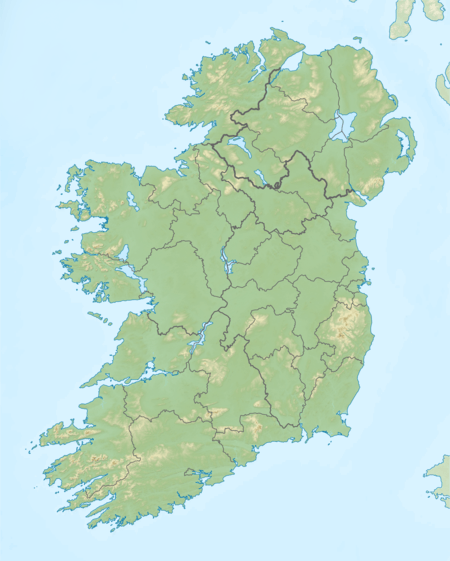Upton train ambush
The Upton train ambush took place on 15 February 1921, during the Irish War of Independence. The Irish Republican Army (IRA) mounted an attack on a train carrying British soldiers at Upton, County Cork. The action was a disaster for the IRA; three of its volunteers were killed and two wounded. Six British soldiers were wounded, three seriously. Six civilian passengers were killed and ten wounded in the crossfire.
| Upton train ambush | |||||||
|---|---|---|---|---|---|---|---|
| Part of the Irish War of Independence | |||||||
 The disused station in 2005 | |||||||
| |||||||
| Belligerents | |||||||
|
(Essex Regiment) |
(3rd Cork Brigade) | ||||||
| Commanders and leaders | |||||||
|
| |||||||
| Strength | |||||||
| 50 soldiers | 13 volunteers | ||||||
| Casualties and losses | |||||||
| 6 wounded | 3 killed, 2 wounded | ||||||
| 6 civilians killed in crossfire, 10 wounded | |||||||
 Location within island of Ireland | |||||||
Background
According to a study of the region, Cork was "by far the most violent county in Ireland" during the War of Independence and had several active guerrilla brigades.[1] Of these, the Third (west Cork) was one of the most effective and it was a unit from this Brigade that carried out the Upton ambush.[2]
Up until the end of 1920, the British had been unable to move troops by train, due to a nationwide boycott by railway workers of trains carrying the British military. However, this strike was lifted in December 1920.[3] While this helped the British military's mobility, it also gave the IRA a new target: trains carrying soldiers. A week before the Upton ambush, the local IRA had made a successful attack on a train travelling from Killarney to Millstreet near Drishanbeg, killing one sergeant and wounding five more soldiers.[3]
Ambush
Five days after the Drishanbeg ambush, plans were made for an attack at Upton and Innishannon railway station on a train travelling between Cork city and Bandon. The ambushers, led by Charlie Hurley, were 13 strong but had only 7 rifles, the remainder being equipped only with revolvers or semi-automatic pistols.[2] They took up position at the station ten minutes before the train pulled in, imprisoning the station master, clearing the station and taking cover behind sacks of grain and flour taken from a store.
The train was carrying around 50 British soldiers of the Essex Regiment, who were mingled with civilian passengers throughout the train's carriages. The IRA party was therefore quite heavily outnumbered and out-gunned. However they were not warned of this, as two IRA scouts, who were supposed to have been on the train and signalled to them of British numbers, never turned up.[2] They also wrongly believed that the British troops were all in the central carriage. As a result, when the IRA opened fire on the train, there were heavy civilian casualties. The New York Times reported that "a shower of bullets was rained on the train, practically every compartment being swept".[4]
The firefight lasted for only ten minutes, but in that time six civilian passengers were killed and ten wounded in the firing between the British and IRA. Six British soldiers were also injured, three of them seriously.[4] Two IRA volunteers were killed outright, another was fatally wounded and two more were badly wounded but survived.[2][5] Charlie Hurley, who had led the ambush, was among the wounded, being struck in the face by a bullet.[2] IRA leader Tom Barry later wrote, "Through some miracle, the nine unwounded and two wounded got away across country, in small parties, with the British following close behind".[6] Three civilian passengers, one unwounded and two wounded were detained by the British on suspicion of belonging to the ambush party.[4]
Aftermath
The Upton ambush was part of what Tom Barry described as "twelve dark days" for the 3rd Cork Brigade of the IRA. Between 4 February and 16 February, eleven members of the Brigade were killed. One was shot dead by British troops when they raided a safehouse on the 4th, another died in an accidental shooting on the 7th, two more (the Coffey brothers) were assassinated in their beds on the 14th by Black and Tans or Auxiliaries, three died at Upton on the 15th and four were killed on the 16th when they were arrested by the Essex Regiment in Kilbrittain while digging a trench and shot dead.[7] Of the eleven dead, only those at Upton were killed in combat.
The Upton attack also highlighted the dangers, and particularly the risk to civilians, of attacking trains carrying troops. Only a month later at the Headford Ambush in neighbouring County Kerry, an IRA column successfully attacked a train-load of troops, but again, there were civilian casualties alongside the IRA and British Army losses. One of the three men captured by the British at Upton is reported to have given information leading to the Third Cork Brigade's main column of over 100 fighters almost being encircled at the Crossbarry Ambush. Hurley himself was killed in this action.[8]
The Upton ambush was later made famous in a popular 1960s Irish ballad titled "The Lonely Woods of Upton".[9]
Notes
- Hart 1998, p. 50–51.
- Barry 1981, p. 93.
- Hopkinson 2002, p. 112.
- New York Times 16 February 1921
- Hopkinson 2002 p. 112–113.
- Barry 1981, p. 94.
- Barry 1981, p. 96–98.
- Hopkinson 2002, p. 111.
- Begley 1999, p. 112
References
- Hart, Peter (1998). The IRA and its Enemies: Violence and Community in Cork 1916–1923. New York: Oxford University Press. ISBN 0-19-820537-6.
- Barry, Tom (1981). Guerrilla Days in Ireland. Anvil Books. ISBN 0-900068-57-4.
- Hopkinson, Michael (2002). The Irish War of Independence. Gill & Macmillan. ISBN 0-7171-3741-4.
- Begley, Diarmuid (1999). The Road to Crossbarry: The Decisive Battle of the War of Independence. Deso Publications. ISBN 0953609901.